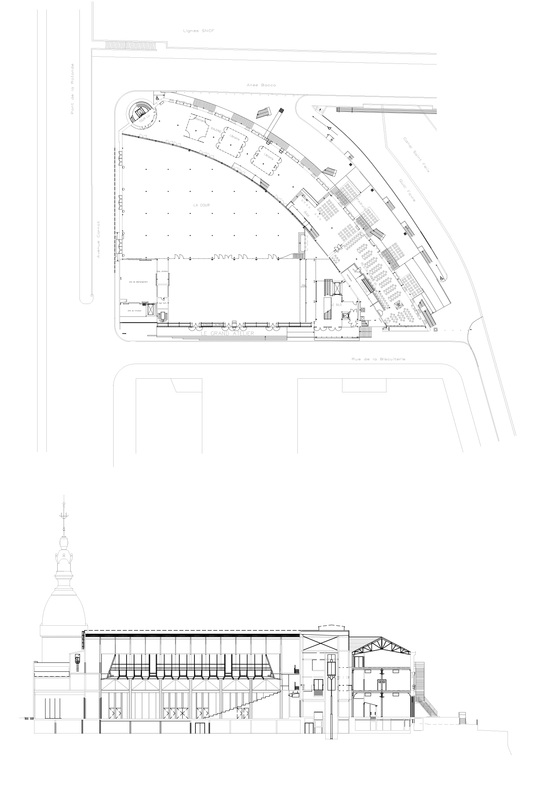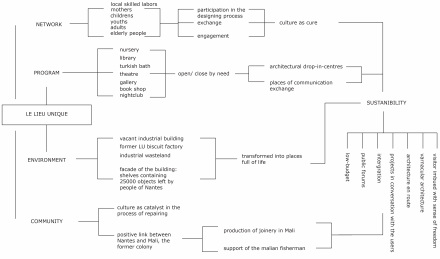|
Original drawings by students
Original diagram by students.
|
Architecture Case Study by
Anastasia Vitusevych and Lachlan McArdle Le Lieu UniqueRochelle, France
Patrick Bounchain The Lieu Unique is a space which allows creative types to interact in artistic exploration. The informal space and the progrmas it facilitates produces a ‘cultural effervessance’ and conviviality. It proudly boasts a spirit and venue within the city for curiosity and discovery of different areas of the arts: visual arts, theater, dance, circus, music, literature, philosophy, architecture and cuisine. The mixed use space contains a bar, a restaurant, a bookstore, a hammam, a day nursery and a gift shop. These are all contained in the remnants of what used to be a biscuit factory, identified by the tower at the corner. The iconnic tower gives way to a 360 degree view of the city, when climbed by visitors and locals alike. The Lieu hosts several events and festivals each year, which connect the creative types who occupy the space year round, with the locals of the city and visitors alike. These festivals an events offer a broad range of things which cover a wide array of interests from the public. These include shows (theater, dance, circus, music, literary meetings, philosophical debates), exhibitions, residencies for artists, recurring events and festivals, and workshops. Sustainability
Approach Le Lieu Unique inhabits what was a dilapidated industrial site sitting remnant since 1974. The demolition of the factory left only a decapitated tower and some of the structure of what stood previously. This cluster of un-organised structures and disused spaces sat idle in the city and became a cultural squat. However, in 1994 it hosted the fourth instalment of the festival Les Allumées. This festival had been created by a local nomadic association CRDC (Centre de recherche pour le développement culturel – Research centre for cultural development) and featured for 6 days and 6 nights. It hosted exhibitions by artists from some of the worlds largest cities: Barcelona, St Petersburg, Buenos Aires, Naples, Cairo. It was after the 1994 instalment that the director of CRDC, Jean Blaise, chose to settle on a permanent site for future exhibitions. Blaise applied to the city of Nantes to create a place where life could exist spontaneously side by side with art in its more contemporary way. The city purchased the building in 1995 and it was saved from demolition when declared a protected site. The architect Patrick Bouchain designed the renovation of the industrial identity of the site, and saw the tower rebuilt. The Lieu Unique was opened on the 30th December 1999 by Blaise and his team, during the “End of Century” festival in Nantes. Since which time, it has played host to many cultural events for CRDC. Scales Le Lieu Unique and its many departments (fine arts, theatre, dance, music, literature, …) link with regional, national and international vocations. LU has been described as “A factory producing the imaginary” and follows the ideas of cultural development shared by Blaise and his team at CRDC. The LU was never meant to be a theatre, but more of a centre of the arts which is permanently open to the audience. Blaise described his desire to become the local bistro for contemporary arts both city wide and across Europe. This is why the social spaces are importantly integrated to the centre, not placed beside the artists spaces, to support the creation, and preserve it from the temptation of isolation. Program The LU has hosts multiple events and runs several exhibitions every year, as well as being open to the public full time. It accommodates artistic freedom and integration at the same time. It seeks to blur the boundaries that define artistic genre, by mixing and integrating them at every level, from conception through to final product. By inserting extra programs such as a bar, restaurant, bookstore etc. it has made the LU a place for meddling. The public and artists alike frequent the businesses within and interact at many different levels. Image References Image 1-5: Conatal. Sustainable Design II: Towards a New Ethics for Architecture and the City. |


